History of the Vale of Leven Page 3
Page 1 | Page 2 | Page 4 | Page 5
Balloch Castle, at the mouth of the river Leven, was built by the Earls of Lennox as a robust stone building to replace their existing wooden home at Faslane, probably just before 1238. Balloch Castle was certainly their chief seat from 1238 onwards after Alexander II's charter confirming their possession of the Lennox also threw them out of Dumbarton Castle. Only the ditch of Balloch Castle remains, and it is full of water most of the time giving the impression of being a moat, which was hardly necessary given the proximity to the Leven.
It didn't give the Earls the complete security they sought and 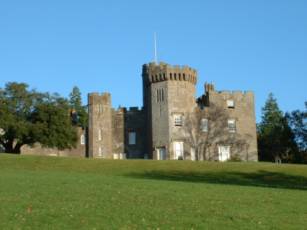 sometime
about 1400 they added a stone castle at the south end of Inchmurrin to their
choice of castles - which also included a castle at Boturich. The ruins of the Inchmurrin castle are clearly visible, and while the Lennox Boturich Castle fell into ruins, the present Boturich castle incorporated some of the ruins when it was rebuilt in the early 1800's.
sometime
about 1400 they added a stone castle at the south end of Inchmurrin to their
choice of castles - which also included a castle at Boturich. The ruins of the Inchmurrin castle are clearly visible, and while the Lennox Boturich Castle fell into ruins, the present Boturich castle incorporated some of the ruins when it was rebuilt in the early 1800's.
Inchmurrin castle didn't bring them much luck, because within 25 years of starting to use it as an administrative headquarters, the family was virtually wiped out by King James I of Scotland in a 2 day show trial and execution at Stirling in July 1425. Countess Isabella, a daughter of the Lennox, had married the son of the Duke of Albany who was James I ‘s uncle. The Duke was instrumental in having James imprisoned in England for 18 years.
By the time James returned, the old Duke of Albany had died and Isabella's husband had succeeded to the Dukedom. Not unnaturally, James was hell-bent on revenge on whomever he could get hold off who had participated in his imprisonment. The Albany \ Lennox family were his first and main targets. While in residence in Balloch Castle, Isabella learned that her husband, 2 sons and father, the Earl of Lennox, had all been executed. She was exiled for the rest of her life to virtual house arrest on Inchmurrin, dying there about 1460 not only as Duchess of Albany but also as Countess of Lennox.
On her death the partition of the Earldom of Lennox took place. This was partly as a result of the execution of so many potential male heirs, but it was also as a result of the agreement made by Isabella's father Earl Duncan, at Inchmurrin, when she married the 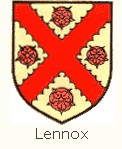 son of the Duke of Albany. There followed a period of protracted lawsuits and pleadings to the King, about which books have been written, and are an excellent illustration of how little the legal profession has changed in its ability to make money. The squabbling between the various parties went on until about 1493, when an agreement gave the Darnley Stewarts about half the estate and the Earldom, and the Napiers of Merchiston and the Haldanes of Gleneagles got broadly speaking a quarter share each.
son of the Duke of Albany. There followed a period of protracted lawsuits and pleadings to the King, about which books have been written, and are an excellent illustration of how little the legal profession has changed in its ability to make money. The squabbling between the various parties went on until about 1493, when an agreement gave the Darnley Stewarts about half the estate and the Earldom, and the Napiers of Merchiston and the Haldanes of Gleneagles got broadly speaking a quarter share each.
The Haldanes gave their name to the Mill of Haldane, which is very appropriate when you consider all the local farms or estates which they inherited which fed the mill. Many of the farm names are slightly different but quite recognisable in modern farms between Balloch and Gartocharn. They include the three Catyrs, Blarquhosh, Ladryshbeg, the twa Boturichis, Blairlosk, Ladrishmor and the twa Achinkerachis. So it is possible to see in the late 1490's some of the shape of the farming area around the Vale, particularly to the northeast, which has survived to this day.
As their avarice in the pursuit of their share of the Lennox Partition foretold, the Darnley Earls turned out to be a pretty rum lot. They mostly gave whoever was the Scottish king a great deal of trouble - from kidnapping James IV to actually going into battle and beating him at Sauchieburn in 1488. James IV reversed this result in a series of replays, but did not punish the then Earl. Indeed James IV frequently visited the next Earl at Balloch Castle. That earl at least had the decency to be joint commander of the Scottish right wing at Flodden in 1513, and be killed along with James IV. After Flodden, Balloch Castle seems to have been abandoned and gradually fell into ruin.
A later Darnley Stewart Earl of Lennox, proved to be an outright traitor, but managed to escape the immediate consequences, and must have felt he had come out of his treachery smelling of roses. He was Governor of Dumbarton Castle when he was caught in a 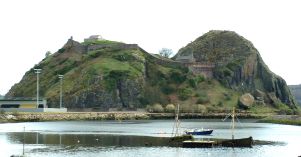 conspiracy to place Scotland under the sway of Henry VIII of England. He escaped to England, and as a reward was married off to a niece of Henry's.
conspiracy to place Scotland under the sway of Henry VIII of England. He escaped to England, and as a reward was married off to a niece of Henry's.
After twenty years in exile, Mary Queen of Scots recalled him, and he was soon followed by his son and heir Lord Henry Darnley. Lord Darnley, had as good a claim on English throne, through his grandmother who was a sister of King Henry VIII, as Mary Queen of Scots had. Mary seems to have fallen for him, and of course that claim strengthened her position as primary claimant to the English throne, which looked as if it would be up for grabs when Elizabeth, who was famously the Virgin Queen, died. Darnley was chosen by Mary Queen of Scots as her second husband in 1565.
The principle worked quite well in the long run, but not quite as Mary had intended. The marriage was a disaster, mainly because Darnley was a complete waste of space, but Mary and Darnley had a son who became James VI of Scotland and James I of the United Kingdoms. He also became the Earl of Lennox when his grandfather was killed at Stirling. Darnley of course never lived to see any of this, being murdered in Edinburgh in February 1567. The exact circumstances remain a mystery, if only because there were so many potential suspects - Mary herself and virtually the whole of the Scottish nobility. Its fair to say that marrying him was a major mistake on Mary's part which she very quickly recognised, and that he was missed by no one.
After James VI acceded to the throne, the title was given to various royal favourites who neither had connection with nor lived in the Lennox. It is now one of the titles held by the Duke of Richmond and Gordon, owner amongst many other things, of Goodwood racecourse in Sussex, which is where he lives.
Throughout most of this time the Colquhouns were also major landowners from what is now Milton along the west side of the Loch to Ardlui and beyond and in Helensburgh, Garelochside and Loch Longside. They have proved much more durable survivors than the Stewarts of the Lennox, perhaps because they played a less prominent role in affairs of state, but not for any less material success. Colquhoun is an unusual clan name in that it 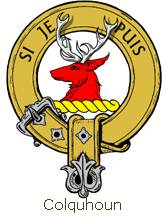 is called after an area of land, which was granted to them, rather being a patronymic (mac or son of someone). The land was the barony of Colquhoun and a Humphrey of Kilpatrick was granted it by King Alexander II probably about 1240.
is called after an area of land, which was granted to them, rather being a patronymic (mac or son of someone). The land was the barony of Colquhoun and a Humphrey of Kilpatrick was granted it by King Alexander II probably about 1240.
The Colquhouns first castle was what is now Middleton farm above Milton (which itself was the Colquhoun's mill town) but they soon built another one on the rock at Dunglass the remains of which can still be seen. Slightly earlier than this, probably about 1220 the Dean of Lennox obtained a grant of the greater part of the land in what became Luss parish. The Dean's family soon began to style themselves “de Luss” and that's name they kept until just over a century later when a de Luss heiress married a Colquhoun.
The Colquhouns relocated to Luss and the de Luss name disappears from history. Sir Robert Colquhoun of Luss is the first of that line and his name is first documented as such in 1368. They built a castle at Rossdhu, the ruins of which are still visible beside the present Rossdhu House which replaced it in 1774, when the Colquhouns moved into the central part with the two wings being added a little later.
From then on they quietly went about their business of marrying into rich families including the Lennoxes, acquiring land, having the occasional feud with their neighbours, fending off cattle thieves from the Highlands and McGregor country across the Loch, and also the occasional family fight. None quite so profound as in 1592 when the head of the clan, Sir Humphrey Colquhoun, was murdered in his stronghold, the castle of Bannachra, the ruins of which can still be seen on the Bannachra estate at Arden. The story goes that he had sought refuge there from pursuing clan members but was illuminated to them on the stairs by the torch of a treacherous servant, and was killed by an arrow shot.
That seems incredibly good shooting by a bow and arrow through a window slot at night, but the story has been accepted down the years. The first reaction was naturally to blame the act on the Colquhoun enemies, the McGregors and the McFarlanes. However, it was later reported that one of his brothers, John, was tried and executed in Edinburgh for the crime later in the year.
This was an era of nae luck for the Colquhouns, because only 11 years later in 1603, they fought and lost the last clan battle in Scottish history - the battle of Glenfruin. The pretext for the battle was the hanging of two McGregors, but there is evidence that the McGregors were egged on by the Earl of Argyll, Colquhoun's bitter enemy at this time - not that they would have needed much encouragement. At any rate 300 lined up on each side, including farmers and tradesmen from the Vale and Dumbarton who had suffered at the hands of the McGregors and therefore sided with the Colquhouns. The McGregor's won an overwhelming victory pursuing the Colquhouns to the very gates of Rossdhu Castle, and killing 140 of them to 2 losses themselves.
They then burned and ravished the whole lands of Luss, and are said to have murdered a party of schoolboys from Dumbarton Grammar school who came to watch their brothers and fathers fight. Sixty or so Colquhoun widows went to King James VI at Stirling to demand retribution. The horrified king's answer was swift. Clan Gregor's name was proscribed, their houses were burned and they were hunted like beasts in the hills. True to the Argyll style, the Earl who had given Clan Gregor encouragement now betrayed the clan chief into capture and execution. Another 25 were  captured and executed. The persecution continued until Charles II's reign when it was called off in recognition of Clan Gregor's support for the Stewart cause in the Civil war. The site of the battle is not now known, but there is a commemoration stone on the old single-track road through Glen Fruin at its northern end as it climbs to the crest of the hill above Faslane.
captured and executed. The persecution continued until Charles II's reign when it was called off in recognition of Clan Gregor's support for the Stewart cause in the Civil war. The site of the battle is not now known, but there is a commemoration stone on the old single-track road through Glen Fruin at its northern end as it climbs to the crest of the hill above Faslane.
The Colquhouns recovered, surviving being on the wrong side in the religious and civil wars of the 17th century - the worst that happened to them was being fined by Cromwell. However the senior male line died out in 1718, with Sir Humphrey Colquhoun MP. He entailed the Luss estates on his daughter and her husband who was a Grant, and since that day the Colquhouns have really been Grants by male descent.
This entailment threw up an illuminating sidelight on how the aristocracy and the honours system then worked - and indeed continue to do. Although Sir Humphrey (and Yes, Minister does seem wholly appropriate in this example of making the system work for you) was perfectly entitled to pass on his material possessions to whomever he wished to (in this case his daughter and his son-in-law, perfectly reasonably), the law said he couldn't pass on the baronetcy except to a male relative, no matter how distant. This was overlooked on Sir Humphrey's death in 1718, but the title came into dispute nearly 70 years later when the Colquhouns of Tillichewan as it then was, laid proper claim to the title. Did the then Colquhoun of Luss incumbents sit around and mope about being Mr and Mrs Grant-Colquhoun? Not a bit of it. Just as easily as ordering an Indian take-away to-day, in 1786 they whistled up a British baronetcy to replace the Scottish one they had been using, but now had to pass on to its rightful owners.
However, we are getting well ahead of the story, and although we'll come back to Sir Humphrey again, its time to return to the Vale around the beginning of the 17th century.
The Reformation kicked off in Scotland in 1560 when much of the church in Scotland decided to break away from the Roman Catholic church. This heralded in about 130 years of dispute and wars, both religious and civil, in Scotland - and indeed in the whole of what became the United Kingdoms. In fact, the transition from Catholicism to Protestantism seemed to go very quietly in this area, and seems to have been virtually complete - a survey in 1755 found not a single Catholic in the whole of the county of Dunbartonshire. The Highlands and islands were a different story, but that did not come into play until the Jacobite risings of 1715 and 1745.
The area had, on the face of it, a high profile in the early days of the Reformation through the Earl of Lennox. As we have seen above, Mary Queen of Scots who had returned to Scotland in 1561 to commence her personal rule, married Lord Darnley her cousin and the son of the Earl of Lennox, in 1565. It's rare for historians to be unanimous about anything,  but by unanimous agreement, Darnley was a complete waste of space both on his own account and also for Mary. However, they had a son who became James VI of Scotland and James I of the United Kingdoms. After Darnley's murder in 1567 and Mary's marriage to Bothwell 2 months later, there was a short sharp revolt and Mary was forced to abdicate in favour of her infant son James VI.
but by unanimous agreement, Darnley was a complete waste of space both on his own account and also for Mary. However, they had a son who became James VI of Scotland and James I of the United Kingdoms. After Darnley's murder in 1567 and Mary's marriage to Bothwell 2 months later, there was a short sharp revolt and Mary was forced to abdicate in favour of her infant son James VI.
In 1568 Mary tried to re-establish herself on the throne, was defeated and fled to England, although her followers fought what proved to be a rear-guard campaign until 1573. Her father in law, the Earl of Lennox, was one of a number of people who took turns to serve short terms as regent without obvious benefit to anyone other than himself and his cronies. His regency had no impact on this area, but when he was killed at Stirling his grandson James VI became the Earl and that was the beginning of the end of the Earldom as a factor in Scottish politics or life.
James VI was a realist whose reign in Edinburgh and London was characterised by peace and stability. As noted his only impact in this area was to outlaw Clan Gregor after the battle of Glen Fruin in 1603 - almost the last thing of note which he did in Scotland before succeeding Elizabeth I to the English throne. His son Charles I who succeeded him in 1625 was not so wise. He wanted to bring the Scottish Church into line with the Anglican Church in England and this caused widespread unrest in Scotland including this area. It started with riots at St Giles cathedral in 1637, followed by the signing of the National League and Covenant in 1638. The general assembly of the Church of Scotland abolished bishops and it was clear that the Scots were heading for a showdown with Charles, which they did in the so-called Bishop's war.
The laird of Dalmoak, John Semphill who was provost of Dumbarton, and who secured Dumbarton Castle for the Covenanters, struck an early blow for the Covenanters. On the  other side, Charles's leader in Scotland was the Marquis of Montrose who had strong local connections not only in land ownership, but also being a brother-in-law of Colquhoun of Luss. Montrose was very competent commander on Charles's behalf winning a number of battles on his behalf. However, this area with the exception of some of the gentry such as Colquhoun of Luss who were Royalists, remained firmly on the Covenanters side. They had made an early alliance with the parliamentary forces, the Roundheads, in the English Civil war. However after he had won the Civil war and executed Charles, Cromwell refused to recognise the Covenant and a war broke out between Cromwell (pictured) and the Scottish Presbyterians in 1650, which the Cromwellian army won fairly quickly.
other side, Charles's leader in Scotland was the Marquis of Montrose who had strong local connections not only in land ownership, but also being a brother-in-law of Colquhoun of Luss. Montrose was very competent commander on Charles's behalf winning a number of battles on his behalf. However, this area with the exception of some of the gentry such as Colquhoun of Luss who were Royalists, remained firmly on the Covenanters side. They had made an early alliance with the parliamentary forces, the Roundheads, in the English Civil war. However after he had won the Civil war and executed Charles, Cromwell refused to recognise the Covenant and a war broke out between Cromwell (pictured) and the Scottish Presbyterians in 1650, which the Cromwellian army won fairly quickly.
Cromwell's main impact in the area was to install a military government under General Monck, which occupied, lost and re-occupied Dumbarton castle, and to fine various members of the gentry for supporting the Royalist cause. Colquhoun had his fine reduced on appeal - as indeed did many of the lesser lights in the Royalist cause.
On Charles II's restoration in 1660 bishops were forced back on the Scottish Kirk, and any ministers who refused to accept them were thrown out of their parishes. With the exception of the minister at Luss, all the local ministers conformed - although the Kilmaronock minister was subsequently deposed. The Luss minister was evicted immediately. He must have been a brave man because Colquhoun was a royalist (as ironically were his great enemies, the McGregors) and supported Charles II. Those who were evicted met outside the church either in the open air or in people's houses, in what became known as conventicles. Conventicles were quickly declared to be illegal, although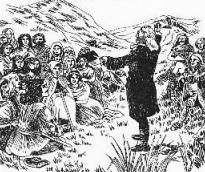 in 1674 the Presbytery of Dumbarton complained that they abounded in this area.
in 1674 the Presbytery of Dumbarton complained that they abounded in this area.
In 1684 a number of local lairds, including Yuill of Darleith and Semple of Dalmoak were fined for holding conventicles. However, the landowners as a group were happy to accommodate the new bishops - led Church of Scotland at this time, and the Covenanters of the 1680's were by and large ordinary people. Opposition to episcopacy was widespread in central and southwest Scotland, among the population at large, but not violently so to begin with. However, the government became increasingly obdurate, Covenanters were hunted down, and many took to the hills and moors often with fatal consequences. The alternative if they were caught was invariably a savage sentence handed down by an increasingly aggressive government.
Although the area was quiet throughout this struggle there are two poignant tales from the 1680's. Robert Nairn was a Covenanter who lived at Napierston. He was a shoemaker and a Covenanter, and he refused to attend Bonhill Parish church, which was now part of a church headed by bishops. This had become a criminal offence, and he had to leave home and hide out with friends or in the open from the officers of the law from Dumbarton who were very actively hunting for him. Amongst the places he hid out for a time was Napierston Wood. However, the cumulative effects of what we would now call living rough, caught up with him, he returned home very ill to die.
When he died the curate of Bonhill Parish Church refused him burial, but some young locals forced the issue, and he was buried in Bonhill Churchyard where a gravestone to him was erected by a descendant, Thomas Nairn of Bankhead in Balloch in 1826. Local tradition had it that he had been sheltered for a time in the farm of the McAllisters of Mid-Auchencarroch (who held on to their strict Covenanting views until the 1850's and beyond) and sure enough when in the early 1800's a barn was demolished in renovations at the farm there, a secret room was uncovered behind a double gable in which they found Nairn's lapstone, just where he had left it 120 years before.
Although Robert Nairn's' case was unique in this area, the hounding of the Covenanters was common elsewhere in Scotland, particularly in the south-west, and by the time James II succeeded to the throne in 1685, revolt was in the air in both Scotland and England. In England it was led by the Duke of Monmouth, while in Scotland a quite separate 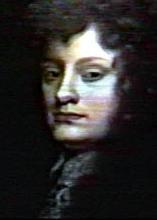 Covenanter-based revolt was led by the Earl of Argyll (pictured), who was almost alone in the Scottish aristocracy in opposing the drift of the King's political and religious policies to the point of taking up arms against him - a very unusual position for an Argyll, and one which no subsequent Earl or Duke ever repeated.
Covenanter-based revolt was led by the Earl of Argyll (pictured), who was almost alone in the Scottish aristocracy in opposing the drift of the King's political and religious policies to the point of taking up arms against him - a very unusual position for an Argyll, and one which no subsequent Earl or Duke ever repeated.
He gathered a small Covenanting army in southeast Argyll and headed for Glasgow where he hoped for more support. He entered the Vale via Glenfruin and came down the Lochside from Arden to Balloch. It is thought he crossed the Leven at the ford at the foot of Heather Avenue and headed up Dalvait Road onto the hillside behind what is now Jamestown. At that point he turned left to-wards Gartocharn rather than heading up over Pappert and the Kilpatrick Hills in more or less a straight line to Glasgow - and in daylight. Probably he was just giving Dumbarton Castle with its government troops a wide berth and was intending to approach Glasgow along the line of what is now the Stockiemuir road.
At any event he shortly ran into some government troops in the area of Gartocharn, and was persuaded to avoid them by changing direction with a night march. This he did and almost immediately became lost in the dark. At dawn he found himself at Old Kilpatrick with only a few hundred men - the rest having headed home during the night. His rising had fallen flat. He was captured at Inchinnan and executed about two weeks later. While the rising had little support at the time, the government of James failed to heed the warning and within 3 years James was on his travels and the rule of the male Stuarts was over for good.
Page 1 | Page 2 | Page 4 | Page 5


